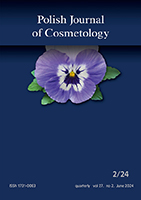search by
Copyright @ Pol J CosmetolComparative studies of antioxidative properties of selected vegetable oils applied in cosmetology by using EPR spectroscopy techniqueSławomir Wilczyński 1/, Marta Wiewióra 1/, Anna Deda 1,2/, Magdalena Zdybel 1/ 1/ Katedra i Zakład Biofizyki, Wydział Farmaceutyczny, Śląski Uniwersytet Medyczny w Katowicach 2/ Zakład Medycyny Estetycznej, Śląski Uniwersytet Medyczny w Katowicach Summary The electron paramagnetic resonance spectroscopy (EPR) were used to assay the capacity of antioxidative properties of selected oils used in cosmetology. The following oils were investigated: argan oil derived by traditional methods (with thermal treatment) (TAO), argan oil obtained by cold pressing (CPAO), jojoba oil (JO) and macadamia oil (MO). Disappearance of standard free radicals (DPPH) signal intensity was evidence of the capacity of antioxidative potential of the studied oils. In the increasing free radicals scavenging capacity, the order was: argan oil derived by traditional methods, jojoba oil, macadamia oil and argan oil obtained by cold mechanical pressing. Obtained results were compared with tocopherols contents (literature data) in the studied oils. No clear correlation between antioxidative potential and tocopherols contents in the oils were found. Probably, also other compounds presented in the samples demonstrate antioxidative potential. It stated significant difference in antiradical efficiency between argan oil obtained by traditional methods (A = 1.1 a.u.) and argan oil obtained by cold pressing (A = 0.41 a.u.). This clear divergence might be linked with the high temperature applied in traditional method of argan oil obtaining thus the thermal degradation process of antioxidants presented in the sample which are responsible for free radicals scavenging. Key words: vegetable oils, argan oil, macadamia oil, jojoba oil, electron paramagnetic spectroscopy (EPR) |




